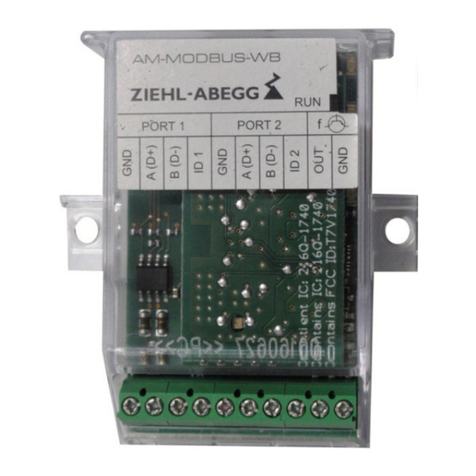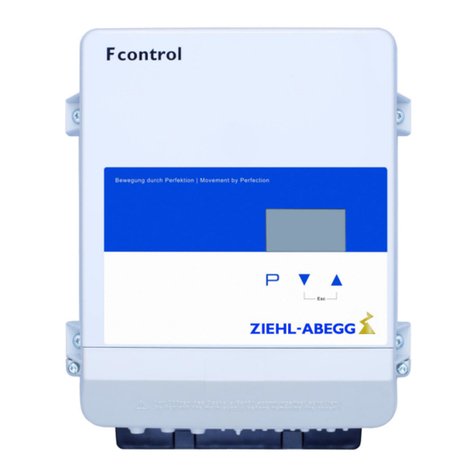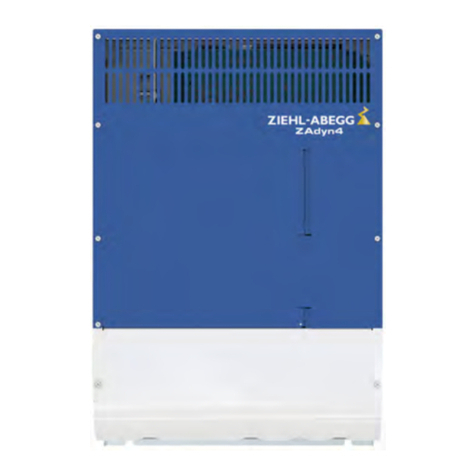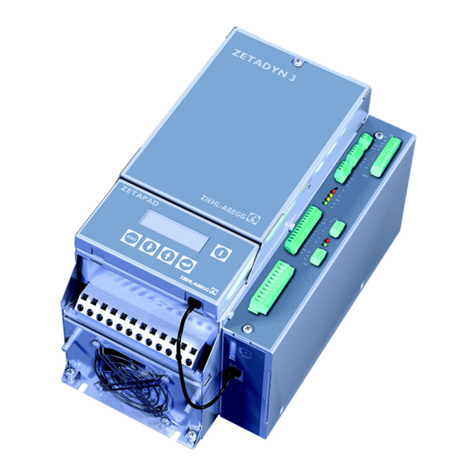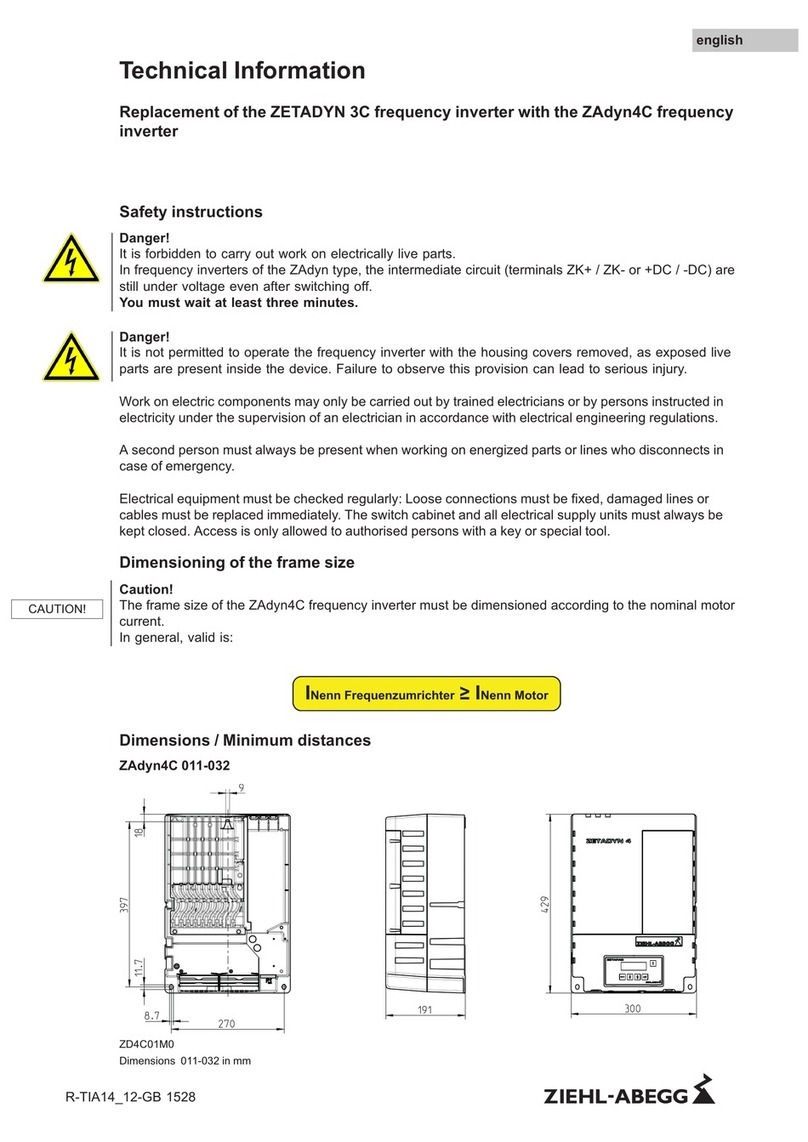9.9.5 Limit . . . . . . . . . . . . . . . . . . . . . . . . . . . . . . . . . . . . . . . . . . . . . . . . . . . . . . . . 46
9.9.6 Minimum speed cut off . . . . . . . . . . . . . . . . . . . . . . . . . . . . . . . . . . . . . . . . . . . 46
9.9.7 Second Group . . . . . . . . . . . . . . . . . . . . . . . . . . . . . . . . . . . . . . . . . . . . . . . . . 47
9.9.8 Reverse action of the control function . . . . . . . . . . . . . . . . . . . . . . . . . . . . . . . . . 47
9.9.9 Controller configuration . . . . . . . . . . . . . . . . . . . . . . . . . . . . . . . . . . . . . . . . . . . 48
9.9.10 Data on the total control deviation . . . . . . . . . . . . . . . . . . . . . . . . . . . . . . . . . . . 48
9.10 IO Setup . . . . . . . . . . . . . . . . . . . . . . . . . . . . . . . . . . . . . . . . . . . . . . . . . . . . . . . . . . . . 49
9.10.1 Analog-Output “A” ............................................... 49
9.10.2 Digital inputs “D1” / “D2” ......................................... 50
9.10.2.1 Menu overview . . . . . . . . . . . . . . . . . . . . . . . . . . . . . . . . . . . . . . . . 50
9.10.2.2 Enable ON/OFF function
|
1D
|
. . . . . . . . . . . . . . . . . . . . . . . . . . . . . 51
9.10.2.3 External fault Function
|
2D
|
............................... 51
9.10.2.4 Limit ON / OFF, Function
|
3D
|
. . . . . . . . . . . . . . . . . . . . . . . . . . . . . 52
9.10.2.5 Switch over Input signal “E1” / “E2”, Function
|
4D
|
. . . . . . . . . . . . . . . 52
9.10.2.6 Set 1/2 or Setpoint 1/2, Function
|
5D
|
. . . . . . . . . . . . . . . . . . . . . . . . 52
9.10.2.7 Intern / Extern Function
|
6D
|
.............................. 53
9.10.2.8 Automatic control / speed manual, Function
|
7D
|
(mode 2.01 ) . . . . . . . 54
9.10.2.9 Reverse action of control function ( 2.01 ), Function
|
8D
|
. . . . . . . . . . . 54
9.10.2.10 Reset, Function
|
10D
|
................................... 54
9.10.2.11 Setting Max. Speed ON / OFF function
|
11D
|
. . . . . . . . . . . . . . . . . . . 55
9.10.2.12 Motorheating ON / OFF, Function
|
12D
|
. . . . . . . . . . . . . . . . . . . . . . . 55
9.10.2.13 “Freeze function” maintain momentary modulation value, Function
|
14D
|
56
9.10.3 Configuration of analog inputs “E1”and “E2” . . . . . . . . . . . . . . . . . . . . . . . . . . . . . 56
9.10.3.1 Signal adaption E1 and E2 . . . . . . . . . . . . . . . . . . . . . . . . . . . . . . . . 56
9.10.3.2 Inverting analog inputs “E1” / “E2” . . . . . . . . . . . . . . . . . . . . . . . . . . . 58
9.10.4 Function and inverting for relay outputs “K1” and “K2” . . . . . . . . . . . . . . . . . . . . . . 58
9.10.5 Programming Add-on module type Z-Modul-B . . . . . . . . . . . . . . . . . . . . . . . . . . . 60
9.10.6 Networking via MODBUS . . . . . . . . . . . . . . . . . . . . . . . . . . . . . . . . . . . . . . . . . 61
9.11 Limits . . . . . . . . . . . . . . . . . . . . . . . . . . . . . . . . . . . . . . . . . . . . . . . . . . . . . . . . . . . . . . 61
9.11.1 Limit indication depending on modulation . . . . . . . . . . . . . . . . . . . . . . . . . . . . . . 61
9.11.2 Limit indication depending on setting or sensor signal . . . . . . . . . . . . . . . . . . . . . . 62
9.11.3 Limit indication depending on (offset) to Setpoint . . . . . . . . . . . . . . . . . . . . . . . . . 63
9.12 Motor Setup . . . . . . . . . . . . . . . . . . . . . . . . . . . . . . . . . . . . . . . . . . . . . . . . . . . . . . . . 64
9.12.1 Setting motor rated current . . . . . . . . . . . . . . . . . . . . . . . . . . . . . . . . . . . . . . . . 64
9.12.2 Setting motor rated voltage . . . . . . . . . . . . . . . . . . . . . . . . . . . . . . . . . . . . . . . . 64
9.12.3 Adjustment of the U/f curve . . . . . . . . . . . . . . . . . . . . . . . . . . . . . . . . . . . . . . . . 64
9.12.4 Setting for Rampup time and Rampdown time . . . . . . . . . . . . . . . . . . . . . . . . . . . 65
9.12.5 Setting Current limit . . . . . . . . . . . . . . . . . . . . . . . . . . . . . . . . . . . . . . . . . . . . . 66
9.12.6 Setting brake function . . . . . . . . . . . . . . . . . . . . . . . . . . . . . . . . . . . . . . . . . . . . 66
9.12.7 Setting Boost value . . . . . . . . . . . . . . . . . . . . . . . . . . . . . . . . . . . . . . . . . . . . . . 67
9.12.8 Setting Derating Alarm . . . . . . . . . . . . . . . . . . . . . . . . . . . . . . . . . . . . . . . . . . . 67
9.12.9 Suppression of speeds . . . . . . . . . . . . . . . . . . . . . . . . . . . . . . . . . . . . . . . . . . . 68
10 Menu tables . . . . . . . . . . . . . . . . . . . . . . . . . . . . . . . . . . . . . . . . . . . . . . . . . . . . . . . . . . . . . . 69
10.1 Menues of operating modes . . . . . . . . . . . . . . . . . . . . . . . . . . . . . . . . . . . . . . . . . . . . . 69
10.2 Possible allocation of the IOs, PINs . . . . . . . . . . . . . . . . . . . . . . . . . . . . . . . . . . . . . . . 75
11 Diagnostics menu . . . . . . . . . . . . . . . . . . . . . . . . . . . . . . . . . . . . . . . . . . . . . . . . . . . . . . . . . 77
12 Events / Fault signals . . . . . . . . . . . . . . . . . . . . . . . . . . . . . . . . . . . . . . . . . . . . . . . . . . . . . . 79
12.1 Display and query of events and malfunctions . . . . . . . . . . . . . . . . . . . . . . . . . . . . . . . 79
12.2 Messages and trouble shooting . . . . . . . . . . . . . . . . . . . . . . . . . . . . . . . . . . . . . . . . . . 79
13 Function extension and version of software . . . . . . . . . . . . . . . . . . . . . . . . . . . . . . . . . . . . 82
14 Enclosure . . . . . . . . . . . . . . . . . . . . . . . . . . . . . . . . . . . . . . . . . . . . . . . . . . . . . . . . . . . . . . . . 82
14.1 Technical data . . . . . . . . . . . . . . . . . . . . . . . . . . . . . . . . . . . . . . . . . . . . . . . . . . . . . . . 82
14.1.1 Performance reduction during elevated ambient temperatures . . . . . . . . . . . . . . . . 83
14.2 Connection diagram . . . . . . . . . . . . . . . . . . . . . . . . . . . . . . . . . . . . . . . . . . . . . . . . . . . 84
Operating Instructions Fcontrol – model series FXET4/6/10AMQ
L-BAL-E079-GB 1706 Index 008 Part.-No.
4/87






